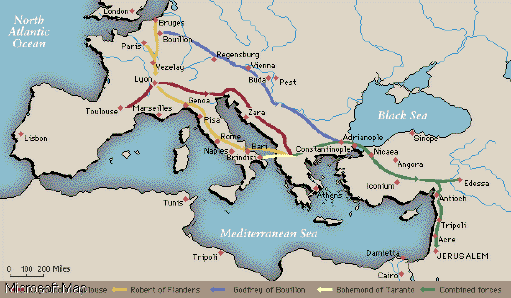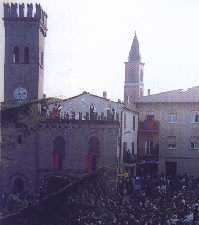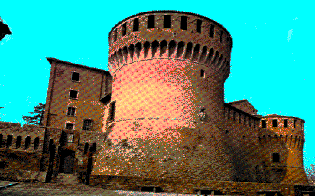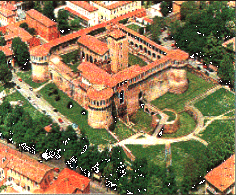
| For a while, our people enjoyed a period of
relative peace and prosperity. In the year 1000 the ancient "Forum Cornelii" was
made of only a few houses around the Church of San Lorenzo, thus occupying a square of no
more than 300 yards per side. The former population, terrified of the possible invasions
and convinced it was too dangerous to live smack in the middle of the Via Emilia, had
built on the neighboring hills two fortified towns, prevalent among which was the
"Castrum San Cassianus," living a pretty much autonomous life. Slowly, merchants and artisans began adding to the few houses and religious orders started building their convents in the neighborhood. Among these, the Orsoline who built along the road that even today bears their name. But for another century what we now call Imola was to remain a sparse agglomerate of a few houses, churches and convents for, in November of 1905, Pope Urban II called the First Crusade into being at Clermont-Ferrand. Urban II brought together all of the bishops and urged them to talk to their friends and fellow villagers and to encourage them to participate in the crusades. Small groups started to form and each group would be self- directing. All the groups planned their own ways to the Constantinople, where they would meet and regroup. They would attack the Turkish forces in Constantinople and hope to regain control of the city. Won over by the enthusiasm of the bands of crusaders passing on the Via Emilia, our people joined the Normans of Southern Italy, led by Bohemond of Taranto and Tancred, who embarked at Brindisi. |
|
| The large Christian armies talked to Alexius I Comnenus, the Byzantium emperor, and agreed to return any of his old land that was recaptured. The armies were skeptical of this demand but agreed anyway. The first attack by the crusaders was on Anatolian, the Turkish capital. Meanwhile the Byzantians were also trying to recapture Anatolian, and later that year, the city surrendered to the Byzantians instead of the crusaders. Clearly, the Byzantians were using the crusaders as pawns to achieve their own goals. The crusaders again met and crushed the Turkish army scoring a great victory which boosted the troops' moral. Then they captured Antioch and held off relief forces sent to help the Turks. Finally, the crusaders moved on to their main goal-Jerusalem! The city was under Egyptian control and was heavily guarded but the crusaders set up siege machines and, received reinforcements from Genoa, scaled the walls and took the city. Everyone in the city was massacred in the belief that the blood of the former holders purified it. Jerusalem was under crusader control for the next generation or so and they brought in people to inhabit the Holy Land. |
| Back from the First Crusade loaded with gold and loot taken from the sack of Antioch, which had inured to Bohemond against Raymond of Saint-Gilles' claims, our family added more land across the Via Emilia between their two strongholds of Tossignano on the hills and Conselice on the West. But they were intent in cultivating it, not building more fortresses. |
|
| Around that time, in the hamlet of Fiagnano, near the "Castrum Casalis Flumanensis," contemporary Casalfiumanense, located only a few miles from our Borgo Tossignano, another lad named Lambert was born to a very poor family. Since from an early age he displayed great intelligence, Lambert was educated together with our own. |
| Lambert grew up to become archdeacon of Bologna and then under Urban II joined the papal court. Paschal II made him cardinal-bishop of Ostia and Calixtus II sent him as legate to the famous Diet of Worms. There his diplomatic skill helped to bring an end to the lay investiture struggle. This success gave Lambert a reputation and made him an outstanding possibility for the papacy. Yet his election would not have happened without our direct support and intervention. With the strong hand of Calixtus removed, Rome rapidly returned to its customary disorder and the Roman mobs’ popular choice was Cardinal Saxo. But we allied ourselves with the then powerful family of Frangipane to secure Lambert’s election and worked towards that end. The cardinals, as often happens chose neither but a dark horse, Theobald Buccapecu, who was called Celestine II. But while the cardinals, Lambert among them, were singing the Te Deum, our side began to shout, "Lambert Pope!" and without more ado hustled Lambert off to a throne and proclaimed him Honorius II. A nasty schism was in the making, but Theobald, a good humble man, seeing that most of the cardinals went over to Honorius, resigned. Honorius also had qualms. Calling the cardinals together he too resigned; but though the cardinals accepted the resignation, they immediately re-elected him. His conscience appeased, Honorius accepted. |
|
 |
Of Honorius’ papacy, of note to us is the fact he gave the entire region of Casalfiumanense (see left) to the Bishop of Imola whose see, at the time, wasn’t in the contemporary city, but in a hamlet nearby which we pretty much controlled. |
| Further, when Roger of Sicily tried to take over Southern Italy, Honorius used both spiritual and temporal arms to stop him. Roger defied both, and Honorius gave in allowing Roger to encroach into a Papal fief by uniting Southern Italy and Sicily. In about a Century, this will bring a nasty dispute in which we participated. In 1130 Honorius felt that he was dying. Since Cardinal Pierleone openly planned to succeed him, Honorius withdrew to a monastery on the Celian where he died on February of 1130. By the mid-1100's we went crusading again. "Why another Crusade?" you may think. The answer is simple: loot. Farming eventually produces wealth, but it’s slow business. Historically, our people have been soldiers, engineers, attorneys, doctors, diplomats and, occasionally, poets and painters with the usual misfit sprinkled here and there thorought the generations. Never a banker or a large-scale merchant. There was little gain in raiding nearby villages. A few cows and chicken, but no gold. In the spirit of Christendom, we discovered that Crusading, instead, offered the prospect of rich cities to plunder and as much gold as a man could carry. Besides, many Kingdoms had been carved at the Saracen’s expense. So, the new generation, brought up hearing tall tales of glory and riches offered by the veterans, was itching to test itself in a new venture. Socio-economic factors contributed as well. At the turn of the Century, farmers had adopted a number of agricultural innovations, including the heavy plow and the horse collar, the three-field system of crop rotation, the use of mills for processing cloth, brewing beer and crushing grain. These innovations, added to the widespread use of iron, increased food production, which in turn increased population, making manpower for expeditions available and, possibly, creating pressure on existing resources which led men to begin looking for external adventures. In addition, the rise of a class of lesser nobles who collected and disposed of local production with relative efficiency made ample resources available.In 1144, Zengi took Edessa. Immediately thereafter, Pope Eugenius II initiated the Second Crusade and we joined Emperor Conrad III's forces. The affair turned into a disaster that, mercifully, didn't last long. King Louis VII, from France, set out to meet the Holy Roman Emperor, Conrad III's army in Jerusalem. Conrad's army began their voyage, only to be ambushed. Afterwards, their supplies and cavalry were drastically depleted. The better half of the French army reached Jerusalem and met up with the small remains of the Germans and the old crusaders. Together they ventured to Damascus and its riches, but failed to take the city and were badly defeated. Everybody had had enough and returned home.By 1150 it was over and our people returned to discover a more immediate threat was developing very close to home: the lack of a major city between them, had invited the neighboring cities of Bologna on the North and Faenza to the South to begin their expansion by capturing several hamlets thus threatening to cut, and isolate, the land we controlled across the Via Emilia between Tossignano and Conselice. |
|
| To counter the threat, beginning in the 1150's the family built and fortified Imola. Make no mistake, from the time of its resurgence to the time when --exiled the family (but more of that anon)--it became a feudal town, Imola lived as a "free commune." Several of our family, more or less in succession, were--not its Lords--its "Gonfalonieri," the "Standard Bearers," which represented the City’s highest office. Our support of the Emperor during the Second Crusade, and of Emperor Frederick I in occasion of the battle of Legnano, when both Bologna and Faenza had marched against him, meant we obtained considerable help and a free hand in rebuilding Imola and settling our scores against the two encroaching enemies. The battle of Legnano was highly unusual for, in the eternal struggle between temporal (the Emperor’s) and spiritual (the Church’s) supremacy, all of Italy was then divided into the two factions of Ghibellines, or the Emperor’s supporters, and Guelphs, or supporters of the Church. We were natural Guelphs as much as Bologna and Faenza were Ghibelline. In this one instance the roles reversed. In a matter of seventy years--the interval of two generations--we built a large City capable of sustaining the combined efforts of Bologna and Faenza to dislodge us from our possessions. |
|
| To do so, we had to procure a large population in a hurry. We accomplished it by occupying Castrum San Cassianus in 1175; Bergullo in 1187; Dozza (see right) which had allied in 1181 with the Bolognese and Faentini, was taken in 1198. Its population was moved to a location within Imola which, to this day, is called "Via delle case di Dozza," or Dozza’s houses; and Gallisterna in 1213. |  |
| Our own armigers occupied the forts but the populations were forcefully moved within the confines of the newborn City. This way, we killed two birds with one stone: took several fortified hamlets which had occasionally supported the Bolognese, and increased tenfold the new-born City’s population. Further, it implied the transfer into the new town of all the churches and monasteries, their riches and their entitlements. | |
 |
In 1187 the nominal Bishop of Imola, Enrico,
was forced to move his see within the city boundaries which began at once the construction
of San Cassiano’s Cathedral and the Palazzo del Comune. By 1225, when we took Castrum
Imolai, the City walls had been completed and, by 1259 the "Rocca" pictured on
the left. The Rocca is known today as "Rocca Sforzesca" after its last occupant, Caterina Sforza. But make no mistake, it was built long before the Sforzas ever existed.
|
| The surrounding lands had to be secured as
well. This was accomplished by founding, in 1199, Castel San Pietro seen at right. A fortified castle which commanded the exit of the Sillaro valley, it twice hosted (1306 and 1338) the University because Bologna had been excommunicated. The tower clock was added in the 1750's. |
|
|
Also, In 1251 a large forest to the South-East of Imola towards the territory of Lugo, which had belonged to the Benedictine order since 754, was given to a large number of Guelph families fleeing the Ghibellines of Brescia and Mantua in Lombardy. Thus, the territory changed its name from "Massa di San Paolo" (Saint Paul’s Monastery) to the present Massa Lombarda (Monastery of the Lombards) seen left. |
|
|
|
| We had, of course, our
share of setbacks. In 1222 we lost Conselice to Emperor Frederick II who razed the
fortress. But, let me fill you in the political background of the age. Frederick of Hohenstaufen was born December 26, 1194. His father was Henry, the Holy Roman Emperor son of Frederick I Barbarossa and King of Sicily by virtue of having married Constance, daughter of Roger II of Sicily. The very one who was allowed to keep that throne by our friend Lambert, Pope Honorious. Keep it in mind, because this Sicily thing isn't over yet. Henry, however, died in 1197, leaving Frederick to become Emperor of the Germans at age two and King of Sicily at age three. Constance died six months later, leaving Frederick under the guardianship of Pope Innocent III. Frederick was raised in the court at Palermo until he took over the government at the age of fourteen. While he apparently loved Sicily above his other possessions he seldom remained there, leaving instead his wife, Constance of Aragon, as regent. Frederick's relations with the Church began peacefully enough, with his former guardian Innocent III gaining him the throne of the Germans and Innocent's successor Honorius crowning him Holy Roman Emperor in 1220. Immediately thereafter, Frederick began making aggressive moves against the Free Communes of Northern Italy, an apparent prelude to an attack on the Papal States. That was when he assaulted and took Conselice. Pope Gregory IX excommunicated Frederick and declared a holy war against him. The war between Frederick and Gregory, and later Innocent IV, spread throughout Italy, into Germany, and in time to all of Europe. The Papacy had little in the way of its own army, but was able to call upon supporters from throughout Christendom to battle the anti-christ Frederick. Frederick had Germany, Sicily, and later Jerusalem, as well as supporters in Italy and other parts of Europe. As a result, rival parties of the Pope and the Emperor, the Guelfs and Ghibellines, battled throughout Europe until Frederick's death in 1250 and, particularly in Italy, long afterwards. By the 1250's, we had weathered the storm, battered but still in the saddle, and had built Imola to its largest expansion as seen in the map below drawn by Leonardo Da Vinci. The City would remain substantially unchanged to the present days. |
||
|
Continues... |
|